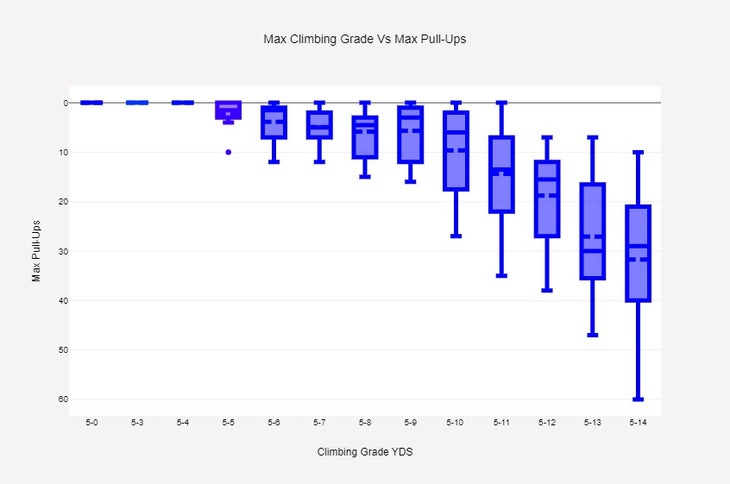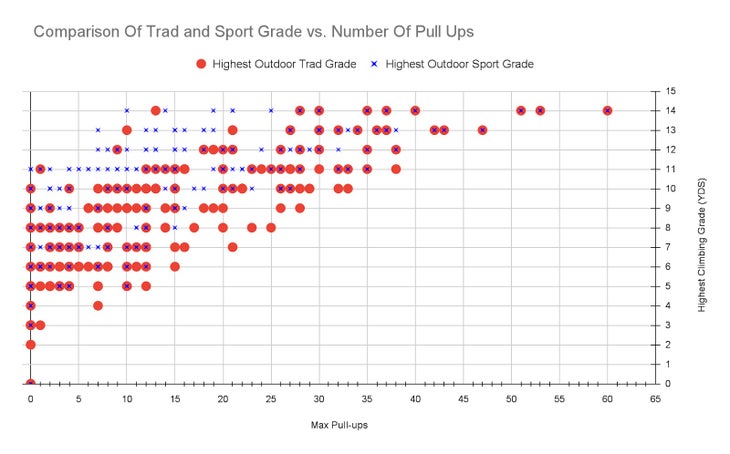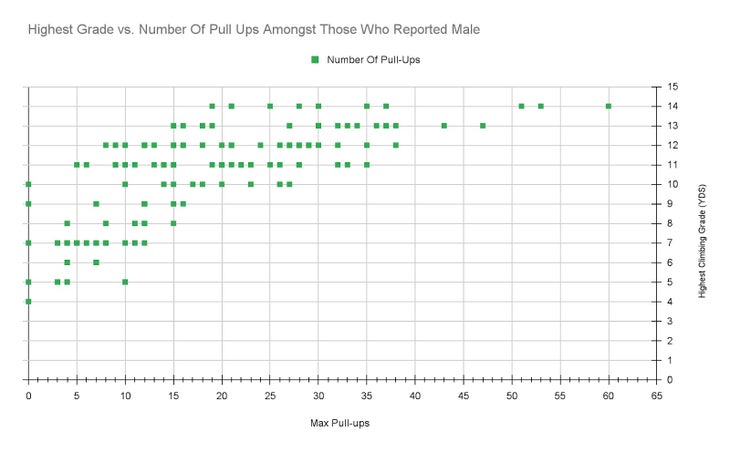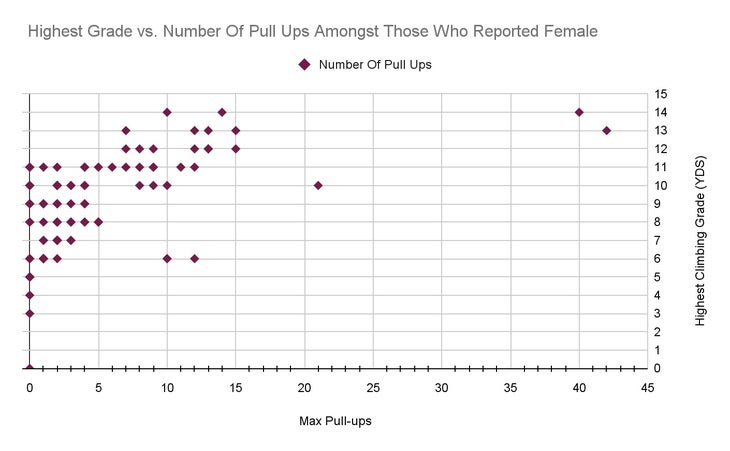Heading out the door? Read this article on the new Outside+ app available now on iOS devices for members! Download the app.
Pull-ups are a standard part of most climbing workouts. And for good reason: It seems obvious that the more pull-ups you can do, the easier it will be to drag yourself up the wall. But as many climbers know, there is much more to climbing training than simply yarding on a pull-up bar. So how important are pull-ups for climbing performance? A look at some new data can reveal insights into the relationship between the number of pull-ups a climber can do and how hard they can climb outdoors.
I surveyed 287 different climbers; 171 identified as male while 116 identified as female. Skill levels varied from complete beginners to professionals, including Paige Claassen and Rob Pizem. The respondents were all asked the maximum number of pull-ups they could do starting with their arms locked straight and pulling their body up until their chin crested the level of the bar, without stopping, and the grade of their hardest outdoor redpoint, for both traditional and sport routes.
Keep in mind when viewing the data that there are possible biases present, which, among others, could include: self-response bias, people who exaggerate their abilities; sampling bias, there was no random sampling when selecting people for survey; grading bias, rock-climbing grades are not incredibly consistent between climbs, climbing types, or climbing areas; and measurement bias, there was no standard measurement set for quality of the pull-ups performed by the respondents.
First Look

At first glance it seems that having a higher max number of pull-ups is associated with a greater redpoint grade. However, a closer look at the plot reveals a large overlap between grades and an increase in max pull-up range as the climbing grade increases in difficulty. There is no distinct separation between the boxes in the plots, like you would expect to see if a climber needed to be able to do at least a certain amount of pull-ups to climb a certain grade. In addition, respondents who climb at the elite grades had the greatest variation in maximum pull-ups; a difference of over 50 pull-ups. Next, examine the low tails of the plot; some respondents were able to send as hard as 5.11 without being able to do even one singular pull-up. Equally surprisingly were the respondents who could barely do 10 pull-ups despite logging the highest redpoint grades (5.14) in the study. All of this evidence suggests that being able to do more pull-ups while training does not directly lead to a harder redpoint grade.
Comparison of Trad and Sport Climbing
So pull-ups don’t seem to affect our overall redpoint grade, but is there any variation between trad and sport climbing?

The graph above shows the differences between respondents’ hardest trad and sport redpoints for the maximum number of pull-ups they could perform. In most cases, the climbers surveyed achieved a greater sport grade than trad. The respondents who could lead at the hardest grades reported more often that their most difficult lead grade was the same for both traditional and sport climbing. An analysis of variance (a statistical test which shows patterns and trends in complex data) was performed. The test indicated that the max number of pull-ups are not explaining much of the difference in hardest redpoint for either style of climbing. According to the data, though, it seems to suggest that max pull-ups might explain the variation in trad redpoint climbing grade slightly better than for sport climbing, but neither are strongly correlated. This means that there is slight evidence that being able to do more pull-ups could have a slightly bigger impact on trad climbing, but again there is not much to support the idea that doing more pull-ups greatly impacts our climbing outdoors in any significant way.
Comparing Results Between Climbers Who Responded As Male Versus Female
If pull-ups don’t seem to affect our climbing grade for trad or sport climbing, is there a difference between male and female climbers? Do pull-ups help advance our climbing for one more than the other?


The two graphs above compare the differences between maximum number of pull-ups and the highest outdoor redpoint grade among climbers who responded as male and female. These graphs show that generally the climbers who responded as female can do less pull-ups while still being able to lead climb at an equal level to those climbers that responded as male. Once again an analysis of variance was performed. The results implied that max pull-ups are not explaining much of the variation in the outdoor redpoint grade for men or women. Even though both show rather poor correlation, the graphs do show that max pull-ups are accounting for the difference in redpoint grade for those who responded as male better than those who responded as female. This could be due to the fact that generally males have greater upper body strength than females.1 Another possible explanation is that male climbers may rely more on upper body strength, while female climbers may use more technique when leading routes of similar grades outdoors. No matter the reason there is little indication that doing more pull-ups will directly result in greater success when climbing outdoors for anyone.
Better Training
Overall the results from this study show that pull-ups don’t have much impact on outdoor redpoint grades, which begs the question: “If not pull-ups, what is actually the best exercise to do to improve climbing?”
The truth is that there is no silver bullet for climbing training. The “best” exercise for a roof-boulderer is completely different from that of an onsight sport climber, or crack fanatic. Find the right materials for your goals by checking out our extensive educational library, instructed by the pros themselves. Paige Claassen leans into precision footwork. Jonathan Siegrist puts on a fingerboarding bootcamp. Heather Weidner explains the art of redpointing. And yes: pull-ups have their place too!
References
- Miller AE, MacDougall JD, Tarnopolsky MA, Sale DG. Gender differences in strength and muscle fiber characteristics. Eur J Appl Physiol Occup Physiol. 1993;66(3):254-62. doi: 10.1007/BF00235103. PMID: 8477683.